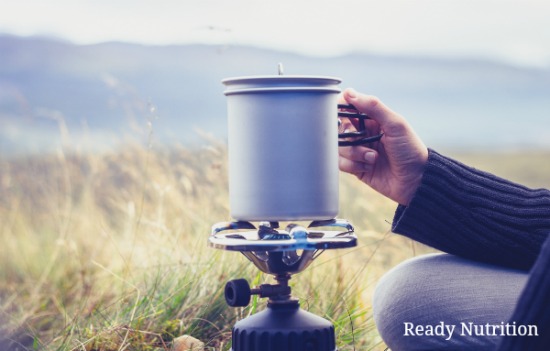
I’m a “throwback,” an “Uncle Cave-Man” type of guy who would prefer to cook everything over an open fire. That being mentioned, I understand that there are instances when that is either impossible or inconvenient…but you still need to cook. This is where your stoves come in, and we’re going to be speaking for the individual, and not the whole entire gigantic family. Four types of stoves we’re going to focus on: Sterno, heat-tablet, propane, and liquid fuel. Let’s do it!
Sterno
This is a type of stove that is usually scoffed at or relegated to the cobwebs of history, but it is actually a pretty safe and reliable piece. I have one that has never been used and is still in the original cardboard sleeve! The Sterno Single-burner Folding Stove, Stock No. 30, that uses a 7 oz. can of Sterno Canned Heat. The Canned Heat is nothing more than gelled alcohol. Set a match to the aperture, and a blue flame will sprout. It doesn’t cook anything really fast, but you can boil water and heat up a can of food with it. The stove folds up nice and compact, and stove and can of Sterno tuck away nicely in a pouch in your pack. Total Cost: about $10 to $15
Heat Tablet
These are stoves that run off of hexamine tablets, commonly known as “heat tablets.” Very popular back in the day in the U.S. Army. Each heat tab will burn for about 9 or 10 minutes. The stove itself is a little steel job with two “legs” that support the “deck” where the heat tab is burned, and a top area to set your pan or pot. Coghlan’s puts out a stove with 24 heat tablets for just under $10, and you can pick up spare tablets just about anywhere. These are 24 tabs for about $4. The whole thing folds to about 4” x 4” x 1” which is really compact. Take some advice, and put them in a Ziploc bag: not just to protect, but for “off-gassing” from the hexamine tablets.
Propane
This is where your small bottles of Coleman propane and others will be fuel for such models as the Scorpion, or the Whisper-Lite. They’ll run you about $40 to $50, plus the propane bottles. They can be a pain in the neck, as you have to use them and then dispose of the bottles.
Liquid Fuel
These would be the ones that use white gas, and/or gasoline, with the ones that use both types being referred to as “Dual Fuel” stoves. Coleman puts out a few models that are good, such as the Sportster II, the 533 series. It has a bottom base that fills up with the fuel. You close it off and then take the priming knob, turn it, and pump air into the chamber, then seal it back up. This burns a blue flame much the same as a gas stove, and you can cook both fast and well on this thing. The main item here is you need to make sure you don’t drop it or have something crush or bend the nozzles or mechanism of the neck, or it will leak. If you’re out of Coleman fuel, you can take some gasoline and burn it in these…a very good feature to have in an emergency or when it hits the fan. These will run you about $50 to $60 in price.
If you can, try and pick up one of each. This falls in line with the “force multiplier” concept, where you’ll always be able to find fuel for at least one of them if push comes to shove. You can order each of them or all of them and have them delivered to your door on www.amazon.com, and take the legwork out of driving all over town.
The stoves can be used for a variety of purposes besides simple cooking. Boiling water and boiling strips of cloth for bandages, as well as sterilizing instruments for minor surgical wounds are just a few. All of these types have compactness and portability to their credit. It’s up to you to determine how to fit them in, as either equipment to be used during the outdoor excursions or preps to stock up on for a disaster. JJ out!